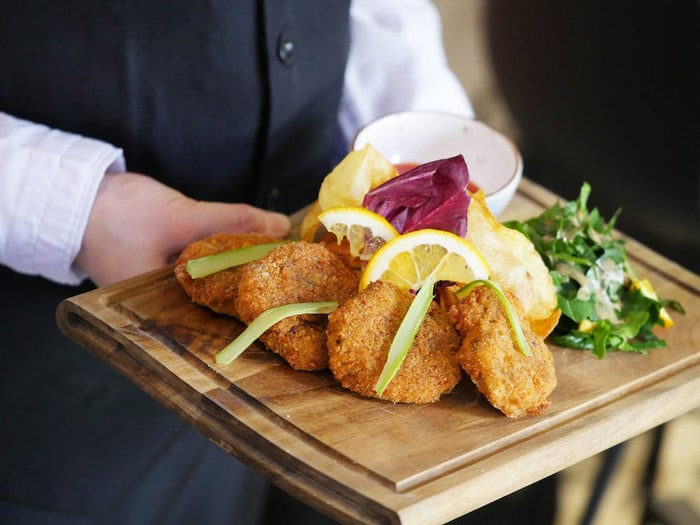
This post provides complete information on the line server job description and career, to help you learn their key duties, tasks, and responsibilities.
It also shows how to become a line server, the various careers opportunities you can explore, and the salary that line servers typically earn.
The qualities, skills, experience, and other requirements you need to meet to be hired for the line server role are also provided in this post.
Please, read on:
What Does a Line Server Do?
Line servers refer to people who provide services that invite interaction with guests.
The line servery job description entails creating orders as requested and educating guests about the menu, and also ensuring that the restaurant is clean and inviting to all guests at all times.
They work on assembly lines, adding food, napkins, cutlery and other items to trays in airline kitchens, cafeterias, hospitals, and similar establishments.
Line servers are expected to welcome and interact with guests throughout their visit, including anticipating and supplying guest needs.
They are always usually busy in the dining room area during peak periods, interacting with customers in the dining room.
It is also part of the role of these servers to frequently clean the service line, equipment, restrooms and dining area, and also maintain a high level of overall restaurant cleanliness.
When line servers are not doing the “serving type of jobs” they may be required to handle cash, including doing the balances to be sure that the floats add up.
The individual holding this position may also be responsible for checking inventory in order to ensure that everything is in order and that he/she has enough of everything.
Sometimes, the server can take the initiative to see if there are other things that he/she may need to do before the rush hour when he/she becomes busy again with doing the main duties of the job.
To succeed on this job, line servers must use a lot of their initiatives in making sure things run smoothly.
Line Server Job Description Example/Sample/Template
An example of the line server job description is shown below. It contains a list of important duties, tasks, and responsibilities line servers mostly carry out in the places they work.
- Store food in assigned containers and storage areas in order to prevent spoilage.
- Inform supervisors when equipment is faulty and when supplies and food are getting low and afterwards order needed items.
- Sanitize and clean work areas, dishes, silverware, equipment and utensils.
- Carry equipment and utensils as well as food supplies to and from storage.
- Wash, cut and peel various foods, such as vegetables and fruits, to prepare for cooking or serving.
- Assist kitchen staff and cooks with various tasks when needed, and provide cooks with needed items.
- Portion, wrap the food and place it directly on plates for service to guests.
- Use electric or manual appliances to clean, slice, peel, and trim foods.
- Receive and store equipment, utensils and food supplies in cupboards, refrigerators and other storage areas.
- Prepare different kinds of foods, such as vegetables, desserts, meats, etc according to customers’ orders or instructions following approved procedures.
- Weigh or measure ingredients; strain and stir soups and sauces.
- Remove and clean kitchen garbage containers.
- Mix ingredients for vegetable salads, molded fruit salads, green salads and pasta salads.
- Make special sauces and dressings as condiments for sandwiches.
- Keep records of the quantities of items and food used.
- Cut, grind, or slice meat, seafood and poultry to prepare for cooking.
- Pack leftover food from dishes into garbage containers.
- Stock refrigerators and cupboards, and tend buffet meals and salad bars.
- Serve food to customers and package take-out foods.
- Sweep and mop kitchen floor, and vacuum dining area.
- Load glasses, dishes and tableware into dishwashing machines.
- Distribute food to waitresses and waiters to serve to customers.
Line Server Job Description for Resume
A resume for seeking the line server job can be prepared with the information in the job description sample presented above.
You can write the work experience section of the resume using the stated duties and responsibilities which applies to your experience.
Line Server Requirements: Skills, Abilities, and Knowledge for Career Success
Applicants seeking employment as line servers are usually required by hiring managers to possess the following qualities to have a chance of being selected for interview.
- Maintaining a positive attitude.
- Should at least have a previous experience as a line server in a school dining facility.
- Possessing creative ideas with food is a plus.
- Should be a team player.
- Must be creative and have a strong commitment to customer service.
Line Server Salary
The average line server salary is around $31,099 per year. The top paying states for line servers are: District of Columbia, $40,482; New York, $36,333; Massachusetts, $36,211; Vermont, $35,964; and California, $34,392 per year.
In the United States, there are currently over 31,176 line servers employed.
Women make up 66.3% of all line servers, while men make up 33.7%.
An employed line server is typically 24 years old.
White people make up the majority of line servers (60.7%), followed by Hispanic or Latino (20.0%), Asian (8.1%), and Black or African American (7.2%).
Women will earn 101% of what men will earn in 2021.

Line Server Career Opportunities
Line servers can explore various career opportunities, such as:
- Food Service Director
The food service director is a managerial position in food service management.
The food service director is responsible for managing all aspects of the food service operation, including staffing, purchasing, inventory, and quality assurance.
2. Food and Beverage Manager
The food and beverage manager can be found in all types of restaurants, hotels, cruise ships, and casinos.
They manage all restaurant staff, such as servers, cooks, and managers.
Their duties include hiring staff, creating a training program for employees, creating marketing plans to increase sales and organizing a schedule for employees.
They are responsible for ensuring food quality and safety standards are being met.
3. Executive Chef
An executive chef has the highest ranking job in most restaurant chains and hotels.
They are responsible for creating menu items, supervising and training other kitchen employees, purchasing ingredients, and organizing inventory.
They must have a background in cooking, typically at least 5 years of experience.
4. Restaurant Manager
Restaurant managers are employed to supervise restaurant employees, such as cooks, hostesses, line servers, and other managers on staff.
They are responsible for scheduling and hiring staff, monitoring staff performance, and ensuring safe food handling standards.
5. Sous Chef
A sous chef is an experienced line server that has been promoted to a management role in the kitchen.
They are responsible for planning menus, training other cooks, assigning tasks to cooks or other management, and maintaining food quality.
6. Restaurant General Manager
The restaurant general manager is responsible for managing all aspects of their restaurant, including staffing, purchasing, and inventory.
They are responsible for creating marketing plans to increase sales, organizing a schedule, and making sure food is always ready and available.
7. Food and Beverage Supervisor
The food and beverage supervisor is responsible for ensuring all food service operations are running smoothly, including staffing, purchasing, and inventory, and quality assurance.
They are also responsible for ensuring all staff members go through proper training.
8. Assistant Restaurant Manager
Individuals are hired and trained to become an assistant restaurant manager.
They are trained in all aspects of management, including food quality, purchasing, and inventory.
9. Kitchen Supervisor
The kitchen supervisor is responsible for scheduling, hiring, and training employees.
They are also responsible for organizing a schedule for staff and ensuring safe food handling standards.
They must have a background in cooking at least 3 years of experience.
Kitchen supervisors are typically 24 years old.
10. Restaurant Director of Operations
The restaurant director of operations is responsible for the complete operation of a restaurant, including staffing, purchasing, and inventory among other things.
They are responsible for creating marketing plans to increase sales, organizing a schedule, and ensuring food quality and safety standards are being met.
Challenges faced by Line Servers on the Job
There are many challenges faced by line servers, including the following issues:
- Poor Safety Protocol
In the restaurant industry, poor safety protocol can lead to serious injuries, property damage, and in some cases, death.
Poor safety protocol includes working in a dangerous area that is not properly ventilated, poorly equipped or full of improper equipment and tools.
2. Aching Feet
Aching feet can be caused by different types of injuries and standing for long periods of time.
The nature of the line server’s job requires them to stand for long periods of time, usually from 8AM to 2:30PM.
Aching feet can be caused by repetitive motion injury, achilles tendonitis, plantar fasciitis, and intervertebral disc disease (IVDD), among others.
3. Low Pay
Low pay is a great challenge faced by line servers on the job as they do not make enough to support their families.
Line servers must provide their families with a living wage so they are not forced to work multiple jobs just to survive.
4. Bullying
Line servers are frequently bullied on the job, which might add to their dissatisfaction with their position.
They are often used as a scapegoat when management does not understand or believe bullying is taking place.
How to Become a Line Server
If you are interested in the line server’s career, here are steps you can follow:
- Get Line Server Education
If you want to be a line server, one of the first things you should think about is how much education you’ll need.
According to research, 19.9% of line servers have a Bachelor’s degree.
In terms of higher education, it is discovered that 0.9% of line servers hold a Master’s degree.
Even though some line servers have a college degree, you can become one with just a high school diploma or GED.
2. Get Line Serving Skills
Before applying for a job, you should practice your line server skills. Some skills commonly requested in line server job descriptions include familiarity with menu items, kitchen equipment, and customer service.
3. Participate in Relevant Training/Internship
Line servers spend less than a month on-the-job training after they are hired.
New line servers learn the skills and techniques required for their specific job and employer during this time.
4. Apply for a Job
Investigate line server responsibilities. Professionally prepare your resume. Apply for a position.
Major Benefits of Line server Career
The biggest benefits of a line server career are:
- Flexible Work Hours
Line servers tend to work in food service and drinking places.
These businesses are often open seven days a week and they have to offer services around the clock, including holidays.
In this type of environment, the line server can choose the hours when they want to work.
Line servers can choose to work only during the day or night shifts if that’s what they prefer.
2. Short on-the-Job Training
Some employers require their line servers to complete an internship before hiring them full-time.
They will also provide short on-the-job training once the line server has completed their internship.
This allows organizations to get the most of their workforce as they do not have to train new employees from scratch.
3. High Pay (for some positions)
While the median pay for a line server is $26,846, there are some that earn a lot more than that.
The highest earnings for a line server are in the $60,000 and above range.
4. Working in a Fast Paced Environment
Line servers can expect to work in a fast paced environment as they are responsible for providing customers with prompt, accurate, and courteous service during their shift.
In addition, they must ensure that the restaurant is organized and running smoothly so that guests have an enjoyable time while dining out or ordering food to go.
5. Work in an Intellectual Environment (for some positions)
The position of a line server can be intellectually challenging. This is especially true when the position involves working at a fine dining establishment or a place that offers wine pairing dinners.
Line servers must have advanced education and be able to discuss drinks, food pairings, and culinary arts with their customers.
6. Opportunities for Advancement
Most line servers start at the bottom of the pay scale until they demonstrate that they can perform their job duties accurately and efficiently.
Once they have been promoted, line servers may advance to manager or even executive level positions.
They can become a sous chef, server trainer, or even a regional manager.
7. Learn New Things
Working as a line server allows the individual to gain knowledge and skills that they can use to excel in the hospitality industry.
Line servers are trained in customer service, beverage service, and inventory management, as well as food preparation skills.
Conclusion
The position of line server is growing in demand, especially among students.
Working as a line server allows students to get experience working in a fast paced environment, and to gain knowledge about food service.












